spare wheel FIAT TALENTO 2020 Owner handbook (in English)
[x] Cancel search | Manufacturer: FIAT, Model Year: 2020, Model line: TALENTO, Model: FIAT TALENTO 2020Pages: 236, PDF Size: 4.86 MB
Page 131 of 236
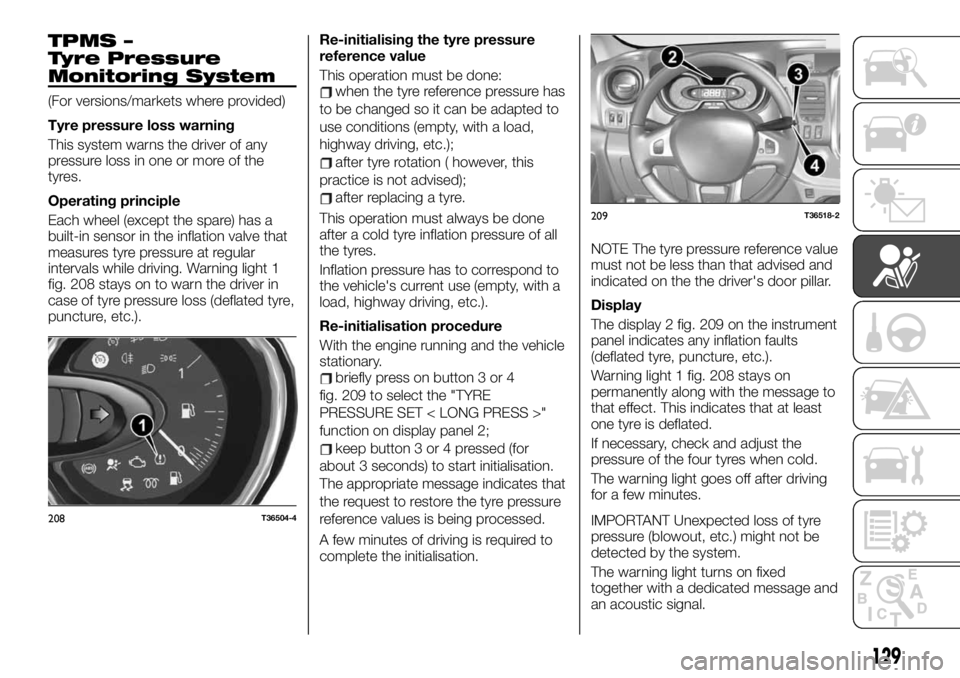
TPMS –
Tyre Pressure
Monitoring System
(For versions/markets where provided)
Tyre pressure loss warning
This system warns the driver of any
pressure loss in one or more of the
tyres.
Operating principle
Each wheel (except the spare) has a
built-in sensor in the inflation valve that
measures tyre pressure at regular
intervals while driving. Warning light 1
fig. 208 stays on to warn the driver in
case of tyre pressure loss (deflated tyre,
puncture, etc.).Re-initialising the tyre pressure
reference value
This operation must be done:when the tyre reference pressure has
to be changed so it can be adapted to
use conditions (empty, with a load,
highway driving, etc.);
after tyre rotation ( however, this
practice is not advised);
after replacing a tyre.
This operation must always be done
after a cold tyre inflation pressure of all
the tyres.
Inflation pressure has to correspond to
the vehicle's current use (empty, with a
load, highway driving, etc.).
Re-initialisation procedure
With the engine running and the vehicle
stationary.
briefly press on button 3 or 4
fig. 209 to select the "TYRE
PRESSURE SET < LONG PRESS >"
function on display panel 2;
keep button 3 or 4 pressed (for
about 3 seconds) to start initialisation.
The appropriate message indicates that
the request to restore the tyre pressure
reference values is being processed.
A few minutes of driving is required to
complete the initialisation.NOTE The tyre pressure reference value
must not be less than that advised and
indicated on the the driver's door pillar.
Display
The display 2 fig. 209 on the instrument
panel indicates any inflation faults
(deflated tyre, puncture, etc.).
Warning light 1 fig. 208 stays on
permanently along with the message to
that effect. This indicates that at least
one tyre is deflated.
If necessary, check and adjust the
pressure of the four tyres when cold.
The warning light goes off after driving
for a few minutes.
IMPORTANT Unexpected loss of tyre
pressure (blowout, etc.) might not be
detected by the system.
The warning light turns on fixed
together with a dedicated message and
an acoustic signal.
208T36504-4
209T36518-2
129
Page 132 of 236
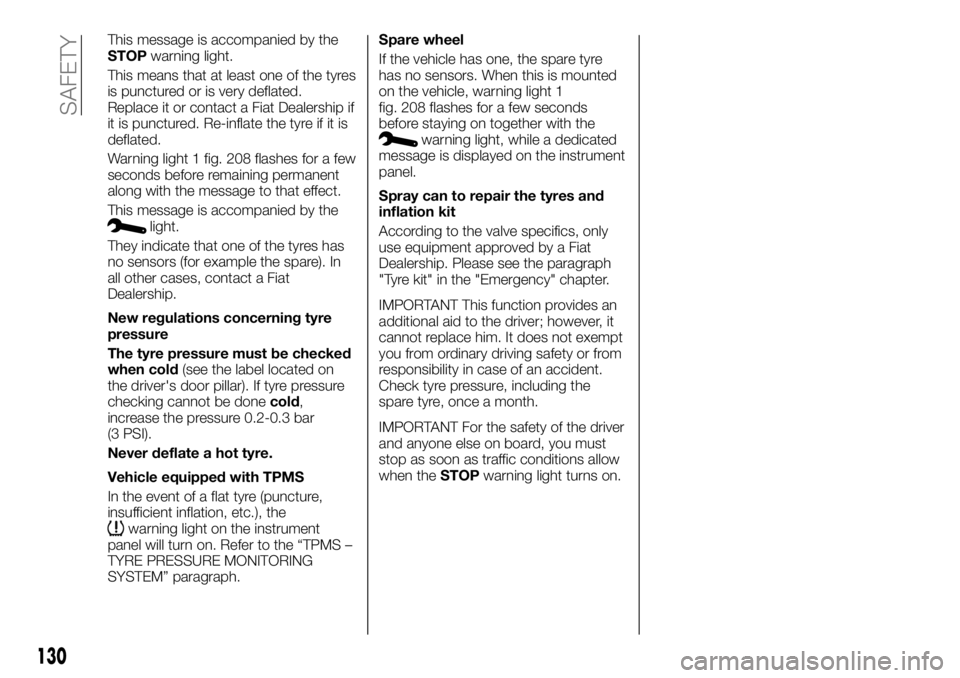
This message is accompanied by the
STOPwarning light.
This means that at least one of the tyres
is punctured or is very deflated.
Replace it or contact a Fiat Dealership if
it is punctured. Re-inflate the tyre if it is
deflated.
Warning light 1 fig. 208 flashes for a few
seconds before remaining permanent
along with the message to that effect.
This message is accompanied by the
light.
They indicate that one of the tyres has
no sensors (for example the spare). In
all other cases, contact a Fiat
Dealership.
New regulations concerning tyre
pressure
The tyre pressure must be checked
when cold(see the label located on
the driver's door pillar). If tyre pressure
checking cannot be donecold,
increase the pressure 0.2-0.3 bar
(3 PSI).
Never deflate a hot tyre.
Vehicle equipped with TPMS
In the event of a flat tyre (puncture,
insufficient inflation, etc.), the
warning light on the instrument
panel will turn on. Refer to the “TPMS –
TYRE PRESSURE MONITORING
SYSTEM” paragraph.Spare wheel
If the vehicle has one, the spare tyre
has no sensors. When this is mounted
on the vehicle, warning light 1
fig. 208 flashes for a few seconds
before staying on together with the
warning light, while a dedicated
message is displayed on the instrument
panel.
Spray can to repair the tyres and
inflation kit
According to the valve specifics, only
use equipment approved by a Fiat
Dealership. Please see the paragraph
"Tyre kit" in the "Emergency" chapter.
IMPORTANT This function provides an
additional aid to the driver; however, it
cannot replace him. It does not exempt
you from ordinary driving safety or from
responsibility in case of an accident.
Check tyre pressure, including the
spare tyre, once a month.
IMPORTANT For the safety of the driver
and anyone else on board, you must
stop as soon as traffic conditions allow
when theSTOPwarning light turns on.
130
SAFETY
Page 155 of 236
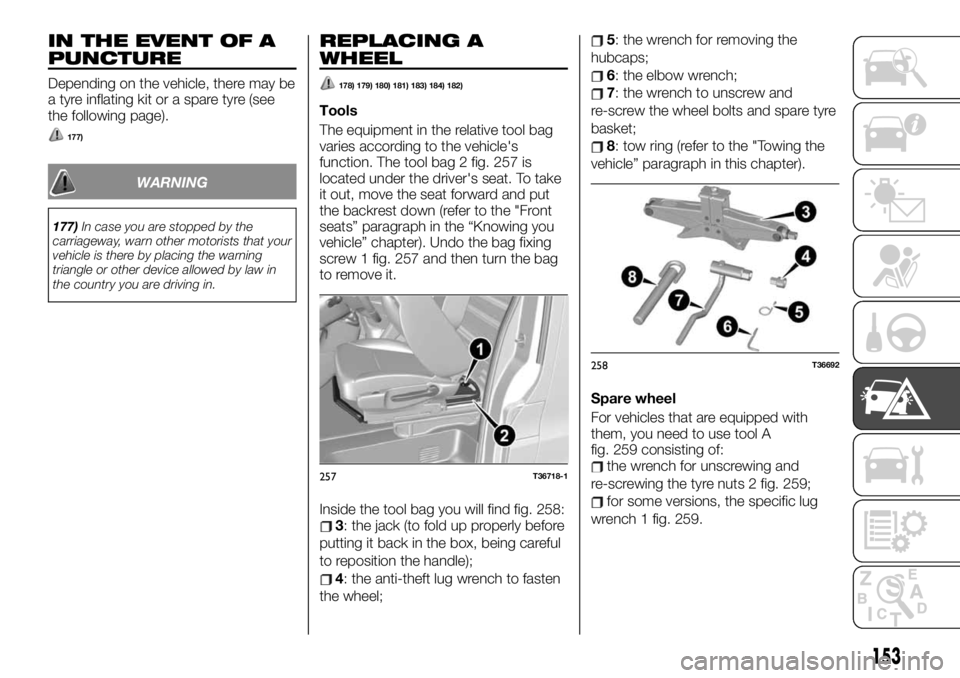
IN THE EVENT OF A
PUNCTURE
Depending on the vehicle, there may be
a tyre inflating kit or a spare tyre (see
the following page).
177)
WARNING
177)In case you are stopped by the
carriageway, warn other motorists that your
vehicle is there by placing the warning
triangle or other device allowed by law in
the country you are driving in.
REPLACING A
WHEEL
178) 179) 180) 181) 183) 184) 182)
Tools
The equipment in the relative tool bag
varies according to the vehicle's
function. The tool bag 2 fig. 257 is
located under the driver's seat. To take
it out, move the seat forward and put
the backrest down (refer to the "Front
seats” paragraph in the “Knowing you
vehicle” chapter). Undo the bag fixing
screw 1 fig. 257 and then turn the bag
to remove it.
Inside the tool bag you will find fig. 258:
3: the jack (to fold up properly before
putting it back in the box, being careful
to reposition the handle);
4: the anti-theft lug wrench to fasten
the wheel;
5: the wrench for removing the
hubcaps;
6: the elbow wrench;
7: the wrench to unscrew and
re-screw the wheel bolts and spare tyre
basket;
8: tow ring (refer to the "Towing the
vehicle” paragraph in this chapter).
Spare wheel
For vehicles that are equipped with
them, you need to use tool A
fig. 259 consisting of:
the wrench for unscrewing and
re-screwing the tyre nuts 2 fig. 259;
for some versions, the specific lug
wrench 1 fig. 259.
257T36718-1
258T36692
153
Page 156 of 236

To extract the spare wheel B fig. 260:with tool A fig. 259 completely undo
nut 5 fig. 260 (right side) and partially
undo nut 3 fig. 260 (left side) in order to
free the basket 4 fig. 260 from nut 3;
free the spare wheel.
Depending on the version, there is
documentation with the instructions
described above in the tool box.
To put spare tyre B fig. 260 back in
place, proceed in the reverse order.
Check that bracket 4 is positioned
correctly before tightening nuts 3 and 5
fig. 260.IMPORTANT In some cases (rear wheel
puncture, vehicle loaded with tow
system) you may need to lift the vehicle
up (from the closest lifting point to the
tyre concerned) to be able to access
the spare tyre.
Wheel plate
Remove wheel plate 9 using wrench 5
fig. 261, inserting the hook in one of the
plate's outside openings.
To refit the plate, position it with respect
to valve 10 fig. 261.
Insert the retaining hooks starting from
the side of valve A, then B and C,
ending with the side opposite valve D
fig. 261.Remove wheel plate 11 fig. 262 with
wrench 5 by inserting the hook in the its
peripheral opening.
To refit it, position the five wheel plate
fasteners corresponding to the 5 fixing
screws fig. 262 and press hard on the
centre of the wheel plate to hook it to
the wheel.
259T36688260T36689261T36693
262T36694
154
IN AN EMERGENCY
Page 157 of 236
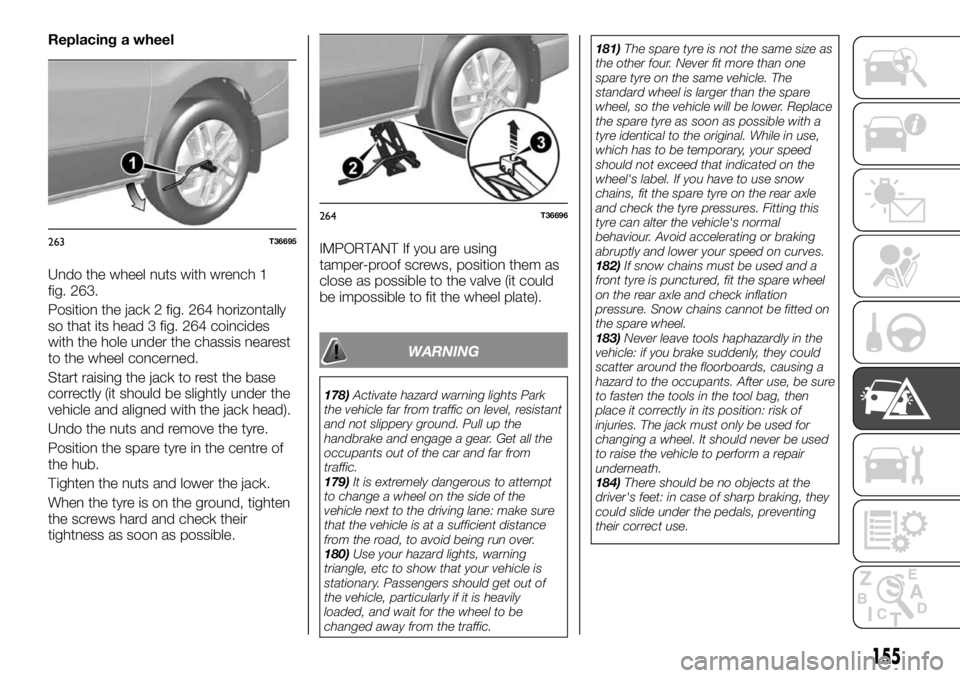
Replacing a wheel
Undo the wheel nuts with wrench 1
fig. 263.
Position the jack 2 fig. 264 horizontally
so that its head 3 fig. 264 coincides
with the hole under the chassis nearest
to the wheel concerned.
Start raising the jack to rest the base
correctly (it should be slightly under the
vehicle and aligned with the jack head).
Undo the nuts and remove the tyre.
Position the spare tyre in the centre of
the hub.
Tighten the nuts and lower the jack.
When the tyre is on the ground, tighten
the screws hard and check their
tightness as soon as possible.IMPORTANT If you are using
tamper-proof screws, position them as
close as possible to the valve (it could
be impossible to fit the wheel plate).
WARNING
178)Activate hazard warning lights Park
the vehicle far from traffic on level, resistant
and not slippery ground. Pull up the
handbrake and engage a gear. Get all the
occupants out of the car and far from
traffic.
179)It is extremely dangerous to attempt
to change a wheel on the side of the
vehicle next to the driving lane: make sure
that the vehicle is at a sufficient distance
from the road, to avoid being run over.
180)Use your hazard lights, warning
triangle, etc to show that your vehicle is
stationary. Passengers should get out of
the vehicle, particularly if it is heavily
loaded, and wait for the wheel to be
changed away from the traffic.181)The spare tyre is not the same size as
the other four. Never fit more than one
spare tyre on the same vehicle. The
standard wheel is larger than the spare
wheel, so the vehicle will be lower. Replace
the spare tyre as soon as possible with a
tyre identical to the original. While in use,
which has to be temporary, your speed
should not exceed that indicated on the
wheel's label. If you have to use snow
chains, fit the spare tyre on the rear axle
and check the tyre pressures. Fitting this
tyre can alter the vehicle's normal
behaviour. Avoid accelerating or braking
abruptly and lower your speed on curves.
182)If snow chains must be used and a
front tyre is punctured, fit the spare wheel
on the rear axle and check inflation
pressure. Snow chains cannot be fitted on
the spare wheel.
183)Never leave tools haphazardly in the
vehicle: if you brake suddenly, they could
scatter around the floorboards, causing a
hazard to the occupants. After use, be sure
to fasten the tools in the tool bag, then
place it correctly in its position: risk of
injuries. The jack must only be used for
changing a wheel. It should never be used
to raise the vehicle to perform a repair
underneath.
184)There should be no objects at the
driver's feet: in case of sharp braking, they
could slide under the pedals, preventing
their correct use.
263T36695
264T36696
155
Page 176 of 236
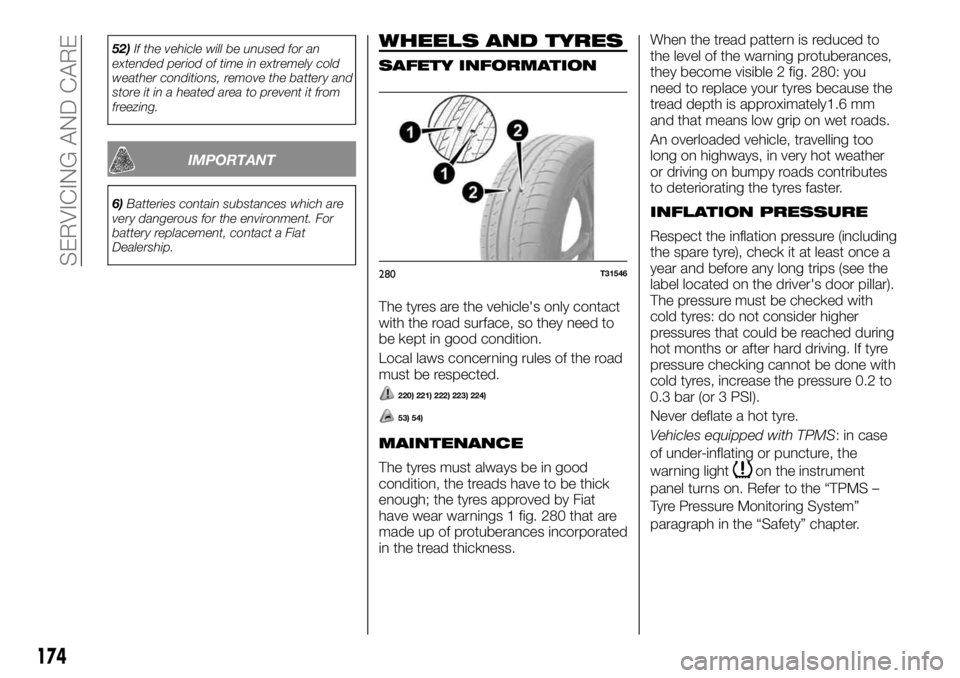
52)If the vehicle will be unused for an
extended period of time in extremely cold
weather conditions, remove the battery and
store it in a heated area to prevent it from
freezing.
IMPORTANT
6)Batteries contain substances which are
very dangerous for the environment. For
battery replacement, contact a Fiat
Dealership.
WHEELS AND TYRES
SAFETY INFORMATION
The tyres are the vehicle's only contact
with the road surface, so they need to
be kept in good condition.
Local laws concerning rules of the road
must be respected.
220) 221) 222) 223) 224)
53) 54)
MAINTENANCE
The tyres must always be in good
condition, the treads have to be thick
enough; the tyres approved by Fiat
have wear warnings 1 fig. 280 that are
made up of protuberances incorporated
in the tread thickness.When the tread pattern is reduced to
the level of the warning protuberances,
they become visible 2 fig. 280: you
need to replace your tyres because the
tread depth is approximately1.6 mm
and that means low grip on wet roads.
An overloaded vehicle, travelling too
long on highways, in very hot weather
or driving on bumpy roads contributes
to deteriorating the tyres faster.
INFLATION PRESSURE
Respect the inflation pressure (including
the spare tyre), check it at least once a
year and before any long trips (see the
label located on the driver's door pillar).
The pressure must be checked with
cold tyres: do not consider higher
pressures that could be reached during
hot months or after hard driving. If tyre
pressure checking cannot be done with
cold tyres, increase the pressure 0.2 to
0.3 bar (or 3 PSI).
Never deflate a hot tyre.
Vehicles equipped with TPMS: in case
of under-inflating or puncture, the
warning light
on the instrument
panel turns on. Refer to the “TPMS –
Tyre Pressure Monitoring System”
paragraph in the “Safety” chapter.
280T31546
174
SERVICING AND CARE
Page 177 of 236
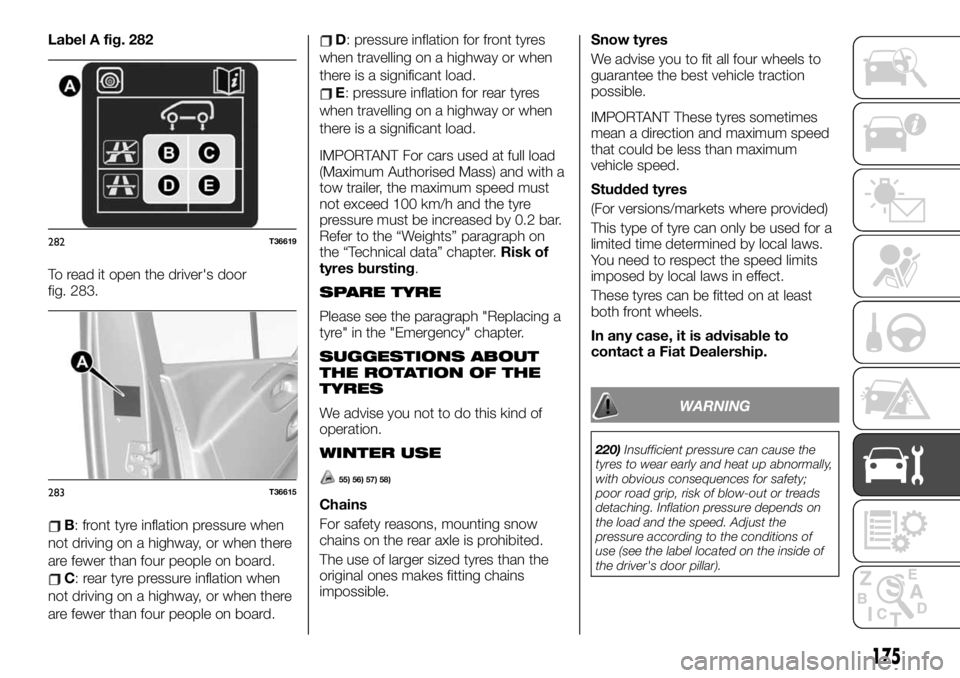
Label A fig. 282
To read it open the driver's door
fig. 283.
B: front tyre inflation pressure when
not driving on a highway, or when there
are fewer than four people on board.
C: rear tyre pressure inflation when
not driving on a highway, or when there
are fewer than four people on board.
D: pressure inflation for front tyres
when travelling on a highway or when
there is a significant load.
E: pressure inflation for rear tyres
when travelling on a highway or when
there is a significant load.
IMPORTANT For cars used at full load
(Maximum Authorised Mass) and with a
tow trailer, the maximum speed must
not exceed 100 km/h and the tyre
pressure must be increased by 0.2 bar.
Refer to the “Weights” paragraph on
the “Technical data” chapter.Risk of
tyres bursting.
SPARE TYRE
Please see the paragraph "Replacing a
tyre" in the "Emergency" chapter.
SUGGESTIONS ABOUT
THE ROTATION OF THE
TYRES
We advise you not to do this kind of
operation.
WINTER USE
55) 56) 57) 58)
Chains
For safety reasons, mounting snow
chains on the rear axle is prohibited.
The use of larger sized tyres than the
original ones makes fitting chains
impossible.Snow tyres
We advise you to fit all four wheels to
guarantee the best vehicle traction
possible.
IMPORTANT These tyres sometimes
mean a direction and maximum speed
that could be less than maximum
vehicle speed.
Studded tyres
(For versions/markets where provided)
This type of tyre can only be used for a
limited time determined by local laws.
You need to respect the speed limits
imposed by local laws in effect.
These tyres can be fitted on at least
both front wheels.
In any case, it is advisable to
contact a Fiat Dealership.
WARNING
220)Insufficient pressure can cause the
tyres to wear early and heat up abnormally,
with obvious consequences for safety;
poor road grip, risk of blow-out or treads
detaching. Inflation pressure depends on
the load and the speed. Adjust the
pressure according to the conditions of
use (see the label located on the inside of
the driver's door pillar).
282T36619
283T36615
175
Page 191 of 236
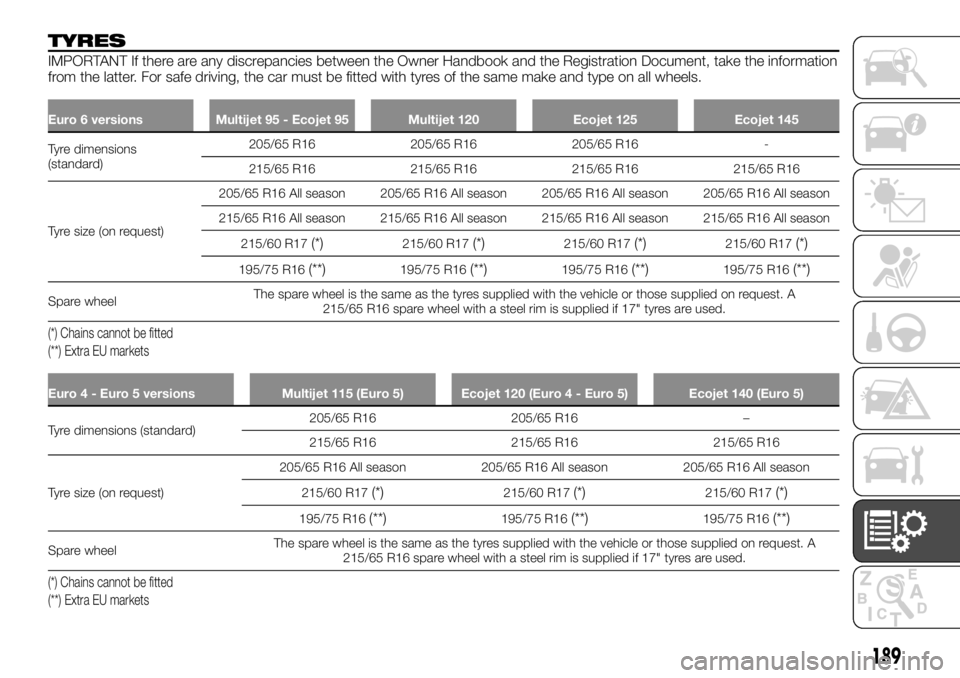
TYRES
IMPORTANT If there are any discrepancies between the Owner Handbook and the Registration Document, take the information
from the latter. For safe driving, the car must be fitted with tyres of the same make and type on all wheels.
Euro 6 versions Multijet 95 - Ecojet 95 Multijet 120 Ecojet 125 Ecojet 145
Tyre dimensions
(standard)205/65 R16 205/65R16 205/65 R16 -
215/65 R16 215/65 R16 215/65 R16 215/65 R16
Tyre size (on request)205/65 R16 All season 205/65 R16 All season 205/65 R16 All season 205/65 R16 All season
215/65 R16 All season 215/65 R16 All season 215/65 R16 All season 215/65 R16 All season
215/60 R17
(*)215/60 R17(*)215/60 R17(*)215/60 R17(*)
195/75 R16(**)195/75 R16(**)195/75 R16(**)195/75 R16(**)
Spare wheelThe spare wheel is the same as the tyres supplied with the vehicle or those supplied on request. A
215/65 R16 spare wheel with a steel rim is supplied if 17" tyres are used.
(*) Chains cannot be fitted
(**) Extra EU markets
Euro 4 - Euro 5 versions Multijet 115 (Euro 5) Ecojet 120 (Euro 4 - Euro 5) Ecojet 140 (Euro 5)
Tyre dimensions (standard)205/65 R16 205/65 R16 –
215/65
R16 215/65 R16 215/65 R16
Tyre size (on request)205/65 R16 All season 205/65 R16 All season 205/65 R16 All season
215/60 R17
(*)215/60 R17(*)215/60 R17(*)
195/75 R16(**)195/75 R16(**)195/75 R16(**)
Spare wheelThe spare wheel is the same as the tyres supplied with the vehicle or those supplied on request. A
215/65 R16 spare wheel with a steel rim is supplied if 17" tyres are used.
(*) Chains cannot be fitted
(**) Extra EU markets
189